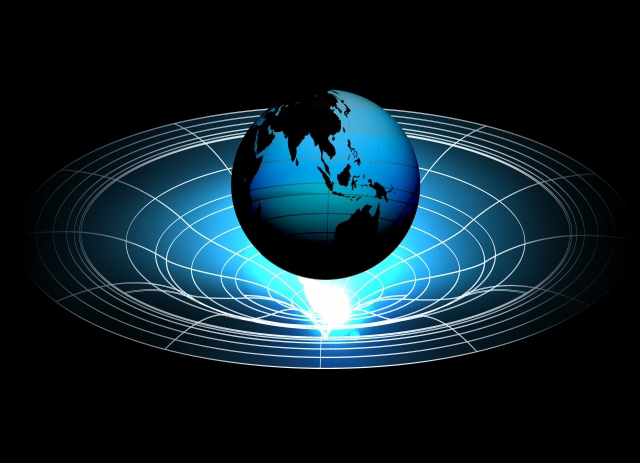重力の探求 The Pursuit of Gravity
1. 重力の歴史的な理解
重力についての最初の明確な理論は、アイザック・ニュートンによって17世紀に提唱された。「万有引力の法則」として知られるこの理論は、あらゆる物体が質量を持つ限り、互いに引き寄せ合うという原理を示している。ニュートンは、この法則を使って、惑星が太陽の周りを回る軌道の形を説明し、地球上での物体の落下運動も説明した。
だが、ニュートンの理論には限界があった。例えば、光が引力を受けるという現象や、極端な質量が引き起こす重力の挙動に関しては、ニュートンの法則では完全に説明できなかった。そのため、19世紀末から20世紀初頭にかけて、アインシュタインの「一般相対性理論」が登場することとなる。
2. 一般相対性理論と重力の革新
アインシュタインの一般相対性理論は、重力を「質量によって空間が歪むこと」として説明した。彼の理論によれば、物体が存在することで周囲の時空が曲がり、その曲がりが物体の動きに影響を与えるという。つまり、重力は物体同士が引き合う力ではなく、物体が空間自体を歪め、その歪みが物体の動きを決定するという新たな視点が示されたのだ。
この理論は、時間と空間が不可分であるという深遠な考え方を提案しただけでなく、光が重力によって曲がる現象(重力レンズ効果)を予測し、実際に観測でも確認されることとなった。アインシュタインの理論は、重力に対する理解を一変させ、私たちが宇宙をどのように理解するかに革命をもたらした。
3. 重力波の発見
今日、重力に関する重要な発見の一つが、2015年にLIGO(レーザー干渉計重力波天文台)によって初めて観測された「重力波」だ。重力波とは、非常に大きな質量の物体が加速することで生じる空間の波動であり、アインシュタインの理論によれば、ブラックホールの衝突や中性子星の合体などで発生する。
この発見は、重力の理解をさらに進める大きな一歩となった。重力波の観測により、私たちは重力を直接的に測定する新たな手段を手に入れ、宇宙の奥深くで起きている現象を観察する新たな窓を開いたのだ。
4. 重力の測定方法
重力を測定する方法は多岐にわたる。地球上で最も基本的な方法は、物体が地面に落ちる速さを測定することだ。ガリレオ・ガリレイの時代から、物体は質量に関係なく、重力によって等しく加速度を受けることが知られている。この加速度は、地球上で約9.8 m/s²である。
しかし、もっと精密な測定を行うには、非常に高精度な機器が必要となる。例えば、地球の重力場を詳細に調査するためには、地上の重力センサーや人工衛星を使った測定が行われる。これらの測定は、地球の内部構造や地殻の不均一性を理解する手助けとなり、地震学や地質学にも応用されている。
5. 未解決の問題と未来の課題
重力に関する研究は、今日でも多くの未解決の問題を抱えている。まず第一に、重力と他の三つの基本的な力(電磁力、強い力、弱い力)の関係は未だに明らかにされていない。特に、量子力学と重力の統一理論は科学者たちの最も大きな挑戦の一つだ。量子重力理論をはじめとする新しい理論は、重力の微視的な挙動を理解する鍵を握ると期待されている。
また、重力波の研究においても、新たな発見が続いているが、それがどのように宇宙の起源や構造に関わるのかについては、まだ解明すべきことが多い。
さらに、私たちの身近な世界でも、重力の理解は日々の技術に影響を与えている。たとえば、人工衛星やGPSの運用、さらには宇宙探査の技術など、重力の精密な測定と理解なしには成立しない。
終わりに
重力というテーマは、私にとって常に魅力的な研究対象であり続けている。それは私たちの身の回りに存在し、日常的に働いている力である一方、その本質を究明するにはまだ多くの謎が残されている。今日の研究が未来にどのような新しい発見をもたらすのか、非常に楽しみであるとともに、その過程に立ち会えることが私の科学者としての喜びでもある。
重力の謎を解明することは、宇宙を深く理解するための鍵となり、私たちの存在そのものに対する認識を変える可能性を秘めているのだろう。
ーーーーーー
【その他】
↓YouTube↓(趣味動画)
・作りたい動画を気ままに投稿
料理・旅etc
↓楽天Blog↓(お買い物情報)
・楽天市場の色々な商品を紹介してます。
↓海外赴任Blog↓
・海外の生活に関して
↓FanBlog↓
ーーーーーー
Today, I again found myself deeply contemplating the force of gravity. It is the most familiar yet one of the most mysterious forces in the world we live in. Throughout human history, the understanding of gravity has been shaped by the efforts of many generations of scientists. However, the fundamental nature of gravity, and the source of this force, is still far from fully understood.
1. The Historical Understanding of Gravity
The first clear theory of gravity was proposed by Isaac Newton in the 17th century. Known as the "Law of Universal Gravitation," this theory states that all objects, as long as they possess mass, attract each other. Newton used this law to explain the orbits of planets around the Sun, as well as the motion of objects falling to Earth.
However, Newton's theory had its limitations. For example, phenomena such as the bending of light by gravity, or the behavior of gravity in extreme masses, could not be fully explained by Newton's laws. This led to the emergence of Albert Einstein's "General Theory of Relativity" in the late 19th and early 20th centuries.
2. The General Theory of Relativity and the Revolution of Gravity
Einstein's General Theory of Relativity redefined gravity, describing it not as a force between objects, but as the warping of space-time caused by mass. According to his theory, the presence of mass bends the surrounding space-time, and this curvature influences the motion of objects. In other words, gravity is not a force pulling objects together, but rather the distortion of space itself, which dictates the movement of objects.
This theory proposed a profound idea: time and space are inseparable. It also predicted phenomena such as the bending of light by gravity (gravitational lensing), which was later confirmed through observation. Einstein's theory revolutionized our understanding of gravity and changed the way we view the universe.
3. The Discovery of Gravitational Waves
One of the most significant discoveries in the field of gravity occurred in 2015, when gravitational waves were first detected by LIGO (Laser Interferometer Gravitational-Wave Observatory). Gravitational waves are ripples in space-time caused by the acceleration of extremely massive objects. According to Einstein's theory, they are generated by events such as the collision of black holes or the merger of neutron stars.
This discovery marked a major step forward in our understanding of gravity. With the detection of gravitational waves, we gained a new means of directly measuring gravity and a new window into observing phenomena deep within the universe.
4. Methods of Measuring Gravity
There are various methods for measuring gravity. The most fundamental approach on Earth is to measure the speed at which objects fall. Since the time of Galileo Galilei, it has been known that objects fall with the same acceleration, regardless of their mass, due to gravity. This acceleration is approximately 9.8 m/s² on Earth.
However, more precise measurements require highly accurate instruments. For example, to study Earth's gravitational field in detail, measurements are made using ground-based gravimeters or satellites. These measurements help us understand the Earth's internal structure and crustal heterogeneity, and they have applications in seismology and geology.
5. Unsolved Problems and Future Challenges
Even today, research into gravity faces numerous unsolved problems. First and foremost, the relationship between gravity and the other three fundamental forces (electromagnetic force, strong force, and weak force) remains unclear. In particular, the unification of quantum mechanics and gravity is one of the biggest challenges facing scientists. New theories, such as quantum gravity, are expected to provide the key to understanding gravity at a microscopic level.
Moreover, while new discoveries continue to emerge in the study of gravitational waves, much remains unknown about how these findings relate to the origin and structure of the universe.
Furthermore, a deeper understanding of gravity impacts our daily technologies. For example, the operation of satellites, GPS systems, and even space exploration rely on the precise measurement and understanding of gravity.
In Conclusion
Gravity has always been an intriguing subject of study for me. It is a force that exists around us and operates in our daily lives, yet there are still many mysteries to unravel about its nature. I look forward with great anticipation to the new discoveries that future research will bring and am excited to be part of this scientific journey.
Unlocking the mysteries of gravity holds the key to a deeper understanding of the universe and has the potential to transform our perception of existence itself.




コメント
コメントを投稿